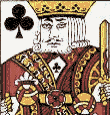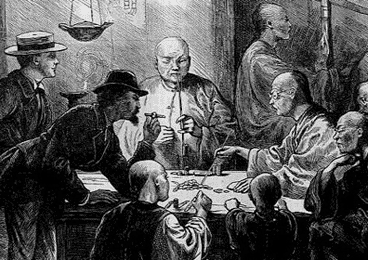 |
Progress Publishing Co. |
 |
|
Keno History |
 |
Progress Publishing Co. |
 |
|
Keno History |

![]()

![]()
Keno History
*******************************************************************
Chinese Origins of Keno
Keno History in the United States
Keno Terms
*******************************************************************
The Origins of Keno
Keno is a lottery-type game. Keno history started around 200 B.C. in China during the transitional period from the Chou (Zhou) Dynasty (1122 B.C. to 256 B.C.) to the Han Dynasty (206 B.C. – 220 A.D.). At that time China was not yet a nation solidified under the rule of one strong central government. It consisted of many cities-states run by feudal lords, which were often in conflicts with their neighbors. Supposedly, one of those lords being in need of finances to build up his army devised the lottery game to generate necessary revenues. That lottery game was the ancestor of modern Keno. The game was conducted by using a ticket containing 120 characters spread over 8 rows 15 characters each. The players had to mark with the brush the characters on the tickets trying to guess five or more of them out of 20 that would be randomly selected later on out of all 120 characters. The brush marks on the ticket looked like spots, so the tickets with, for ex, 10 marked characters were called as 10-spot tickets. In modern casinos you can have 4-spot, 7-spot, 9-spot etc. tickets. The more characters on a player’s card matched with those among the 20 randomly selected and the higher was the wager, the bigger was the reward. The 120 characters on the ticket were the first characters in Chinese poem called “Thousand Character Classic”. The poem was ordered by the Emperor Wu (549 – 502) and the calligrapher Wang Xizhi and composer Zhou Xingsi finished the work. Some historians think that Confucius and his disciples were the authors of the poem. The poem was used to teach children writing and reading.
Due to the possibility of winning a big sum on a cheap ticket, the game became immediately popular. The popularity grew in the following centuries. To make it even more attractive for the customers, 30 characters were dropped from the Keno ticket decreasing the amount of characters to 90. The game, with the help of illegal operators, spread all over China and was played not only in the big cities but also in the small villages. The runners were used to deliver the results to distant locations until eventually, to avoid interception by the authorities they were replaced by the letter-carrying pigeons. The concept and the design of the game stayed the same for twenty centuries and in the middle of the 19th century the Chinese immigrants brought Keno to United States in its pure Chinese form.
Keno History in the United States
Chinese immigrants arrived to build the railroads and work in the mines. Chinese communities were the starting point of the keno history in the United States. Keno became known as the “Chinese Lottery”. First, the game was confined to the Chinese population only. The biggest Keno action was in San Francisco and other big cities with big Chinese communities. It didn’t take long before the game became popular among the Americans. Chinese characters were confusing for the non-Chinese who could not figure out which characters hit and which missed. To make the game more acceptable for the rest of the country the original 90 characters were substituted by Arabic numbers from 1 to 80. To win the prize, the players had to match 5 or more of their numbers with the numbers among the twenty randomly selected. The payoff for the 5 correctly guessed numbers was 2 for 1 and for 10 numbers – 3000 for 1. The legal status of Keno was questionable and the game was played around the law outside of Chinese centers until the legalization of gambling in Nevada in 1931.
The turning point in keno history was Nevada Gambling Act of 1931. This act opened the doors for the games of chance to enjoy their popularity openly without looking over the shoulder every time the bet was made. Almost all existing forms of gambling were legalized. The lotteries, however, including a “Chinese Lottery” were still considered to be illegal. The casino owners tried to argue that Keno was not a lottery, but actually a banking game because the mechanical device called “goose” was employed. The “goose” was a spherical rotating cage with a hole for the numbered balls to roll out one at a time through a long goose-like opening. Gambling authorities did not buy the argument. Instead of arguing further, the casino operators decided to fool the law. They tried to disguise Keno as some form of horse racing. To do that, they assigned horse names to the 80 numbers of the Keno ticket. To make the job complete they called the game Race Horse Keno. The trick worked and Keno was accepted by Nevada’s bureaucrats of gambling. Because of that new name, Keno drawings became known as “races” and that term is still used today. The first man who brought Keno to Nevada was Warren Nelson. He used to run illegal Keno operations in Montana in 1930s. As soon as he found out about legalized gambling in Nevada, he opened the first Keno game in 1936 in Palace Club in Reno. Shortly after that the first Keno game in Vegas was opened by Joe Lyden at the Fremont.
The next twist in keno history happened in 1951, when Race Horse Keno ran its last miles. At that time United States government passed the law taxing off-track betting. Since Keno was sold to the public as a horse race gambling and not as a lottery, it could be subjected to the new taxes. To avoid paying extra money for the privilege of running the game, casinos dropped the horse names from the Keno tickets and returned to the tickets used before the legalization of the game. Again, the trick worked. It did not even bother Nevada’s gambling authorities, who forgot that Keno had been found to be illegal 20 years earlier, because it looked like and actually was a lottery and not a horse racing.
In the early 1960s few important rules were imposed, which affected the keno players. IRS required the players to collect their winnings immediately as soon as the game ends. If they could not collect before the beginning of the next game, their winnings would become void. The players had to be present during the game and they could not play the tickets in advance. The payout limit of $25,000 and the minimum price of 60 cents per ticket were established by the Nevada Gambling Commission. In the 1970s the payout limit was raised from $25,000 to $50,000 and the minimum price per ticket increased to $1.
Keno Terms
Keno Balls – numbered ping-pong balls. There are 80 balls numbered from 1 to 80.
Keno Lounge – the area of the casino with the keno board where the keno tickets are written and the payoffs are made.
Keno Writer – a casino employee, who prepares players’ tickets, gives them duplicates and pays off winning tickets.
Keno Cage – the area separated from the rest of the keno lounge, where the keno writers work.
Keno Runner – A casino employee, who picks up the tickets from the players outside of the keno lounge, takes them to the keno writer, brings back processed tickets and collects payoffs for the winning tickets.
Keno Board – the big electronic board on the wall in the keno lounge that displays winning numbers.
Caller – a casino employee, who announces winning numbers as they are selected.
Draw or Race – random selection of the 20 winning numbers.
Goose – the part that holds the numbered balls rolled randomly out of the spherical cage.
Catch – the number of correctly guessed numbers.
Rate – the price per ticket.
Rate Card – a casino brochure that explains the types of tickets and the payoff rates.
Solid – a winning ticket with all correctly guessed numbers.
Spot – the number on the ticket marked by a player. 6-spot ticket means a ticket with 6 chosen numbers.
Blank or Blank Ticket – an unmarked keno ticket.
Inside or Original Ticket – the ticket marked by a player and given to a keno writer for processing and making a duplicate.
Outside or Duplicate Ticket – a ticket given to a player by a keno writer as a proof of his bet.
Straight or Regular Ticket – a ticket that represents only one group of numbers, which a player placed his bet on.
Combination or Way Ticket – a ticket with few groups of numbers being played. This ticket gives more than one opportunity to win and represents few bets at the same time.
King Ticket – a ticket, which has one number (the king number) paired with the groups of numbers.
Copyright Progress Publishing Co. 2006
Poker rules